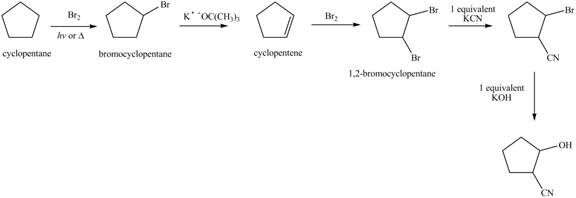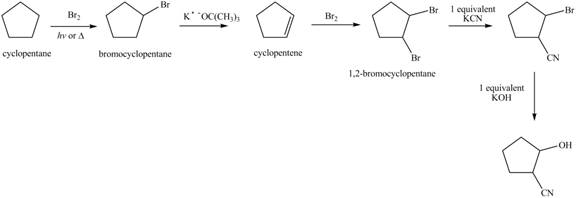
Concept explainers
Devise a synthesis of each compound from cyclopentane and any other required organic or inorganic reagents.
a.  b.
b.  c.
c.  d.
d.  e.
e. 
(a)
Interpretation: The synthesis of given compound from cyclopentane by the use of any other organic or inorganic reagent is to be stated.
Concept introduction: Alkenes undergo bromination reaction at primary, secondary and tertiary carbon atom through free radical mechanism on reaction with
Answer to Problem 15.57P
The synthesis of given compound from cyclopentane by the use of any other organic or inorganic reagent is,

Figure 1
Explanation of Solution
Cyclopentane is used as a starting material and it converts into bromocyclopentane on treatment with

Figure 1
The synthesis of given compound from cyclopentane by the use of any other organic or inorganic reagent is shown in Figure 1.
(b)
Interpretation: The synthesis of given compound from cyclopentane by the use of any other organic or inorganic reagent is to be stated.
Concept introduction: Alkenes undergo bromination reaction at primary, secondary and tertiary carbon atom through free radical mechanism on reaction with
Answer to Problem 15.57P
The synthesis of given compound from cyclopentane by the use of any other organic or inorganic reagent is,

Figure 2
Explanation of Solution
In the first step, cyclopentane undergoes bromination when it is treated with

Figure 2
The synthesis of given compound from cyclopentane by the use of any other organic or inorganic reagent is shown in Figure 2.
(c)
Interpretation: The synthesis of given compound from cyclopentane by the use of any other organic or inorganic reagent is to be stated.
Concept introduction: Alkenes undergo bromination reaction at primary, secondary and tertiary carbon atom through free radical mechanism on reaction with
Answer to Problem 15.57P
The synthesis of given compound from cyclopentane by the use of any other organic or inorganic reagent is,

Figure 3
Explanation of Solution
In the first step, cyclopentane undergoes bromination when it is treated with

Figure 3
The synthesis of given compound from cyclopentane by the use of any other organic or inorganic reagent is shown in Figure 3.
(d)
Interpretation: The synthesis of given compound from cyclopentane by the use of any other organic or inorganic reagent is to be stated.
Concept introduction: Alkenes undergo bromination reaction at primary, secondary and tertiary carbon atom through free radical mechanism on reaction with
Answer to Problem 15.57P
The synthesis of given compound from cyclopentane by the use of any other organic or inorganic reagent is,

Figure 4
Explanation of Solution
In the first step, cyclopentane undergoes bromination when it is treated with

Figure 4
The synthesis of given compound from cyclopentane by the use of any other organic or inorganic reagent is shown in Figure 4.
(e)
Interpretation: The synthesis of given compound from cyclopentane by the use of any other organic or inorganic reagent is to be stated.
Concept introduction: Alkenes undergo bromination reaction at primary, secondary and tertiary carbon atom through free radical mechanism on reaction with
Answer to Problem 15.57P
The synthesis of given compound from cyclopentane by the use of any other organic or inorganic reagent is,

Figure 5
Explanation of Solution
In the first step, cyclopentane undergoes bromination when it is treated with

Figure 5
The synthesis of given compound from cyclopentane by the use of any other organic or inorganic reagent is shown in Figure 5.
Want to see more full solutions like this?
Chapter 15 Solutions
Organic Chemistry
- Devise a synthesis of each compound from cyclohexene and any required organic compounds or inorganic reagents.arrow_forwardDevise a synthesis of each compound from phenol (C6H5OH) and any other organic or inorganic reagents.arrow_forwardDevise a synthesis of each compound from benzene. You may use any other organic or in organic reagents.arrow_forward
- Devise a synthesis of each compound from benzene, any organic alcohols having four or fewer carbons, and any required reagents.arrow_forwardDevise a synthesis of each compound from cyclohexene and anyrequired organic compounds or inorganic reagentsarrow_forwardDevise a synthesis of each compound from benzene.arrow_forward
- Devise a synthesis of attached compound from acetylene and any other required reagents.arrow_forwardDraw a stepwise mechanism for the following reaction that forms ether D. D can be converted to the antidepressant uoxetine (trade name Prozac) in a single step.arrow_forwardDraw a stepwise mechanism for the following reaction that forms ether D. D can be converted to the antidepressant fluoxetine (trade name Prozac) in a single step.arrow_forward
- Draw a stepwise mechanism for the attached reaction that forms ether D. D can be converted to the antidepressant fluoxetine (trade name Prozac) in a single steparrow_forwardDevise a synthesis of attached compound from cyclohexene and organicalcohols. You may use any other required organic or inorganic reagents.arrow_forwardDevise a synthesis of attached compound from benzene, any organic alcohols having four or fewer carbons, and any required reagentsarrow_forward
 ChemistryChemistryISBN:9781305957404Author:Steven S. Zumdahl, Susan A. Zumdahl, Donald J. DeCostePublisher:Cengage Learning
ChemistryChemistryISBN:9781305957404Author:Steven S. Zumdahl, Susan A. Zumdahl, Donald J. DeCostePublisher:Cengage Learning ChemistryChemistryISBN:9781259911156Author:Raymond Chang Dr., Jason Overby ProfessorPublisher:McGraw-Hill Education
ChemistryChemistryISBN:9781259911156Author:Raymond Chang Dr., Jason Overby ProfessorPublisher:McGraw-Hill Education Principles of Instrumental AnalysisChemistryISBN:9781305577213Author:Douglas A. Skoog, F. James Holler, Stanley R. CrouchPublisher:Cengage Learning
Principles of Instrumental AnalysisChemistryISBN:9781305577213Author:Douglas A. Skoog, F. James Holler, Stanley R. CrouchPublisher:Cengage Learning Organic ChemistryChemistryISBN:9780078021558Author:Janice Gorzynski Smith Dr.Publisher:McGraw-Hill Education
Organic ChemistryChemistryISBN:9780078021558Author:Janice Gorzynski Smith Dr.Publisher:McGraw-Hill Education Chemistry: Principles and ReactionsChemistryISBN:9781305079373Author:William L. Masterton, Cecile N. HurleyPublisher:Cengage Learning
Chemistry: Principles and ReactionsChemistryISBN:9781305079373Author:William L. Masterton, Cecile N. HurleyPublisher:Cengage Learning Elementary Principles of Chemical Processes, Bind...ChemistryISBN:9781118431221Author:Richard M. Felder, Ronald W. Rousseau, Lisa G. BullardPublisher:WILEY
Elementary Principles of Chemical Processes, Bind...ChemistryISBN:9781118431221Author:Richard M. Felder, Ronald W. Rousseau, Lisa G. BullardPublisher:WILEY





